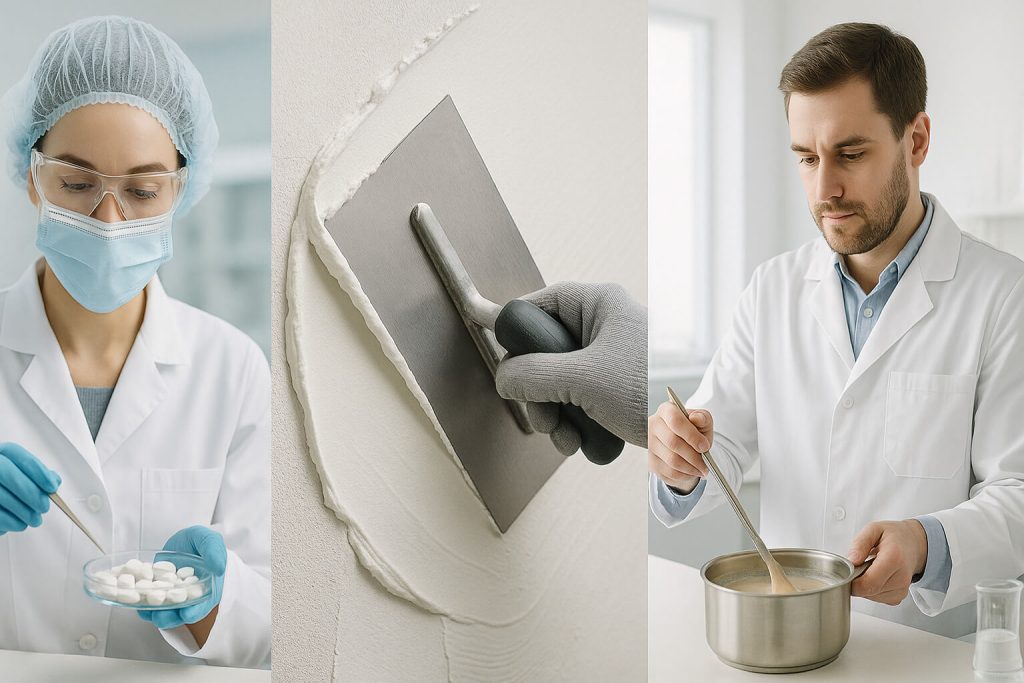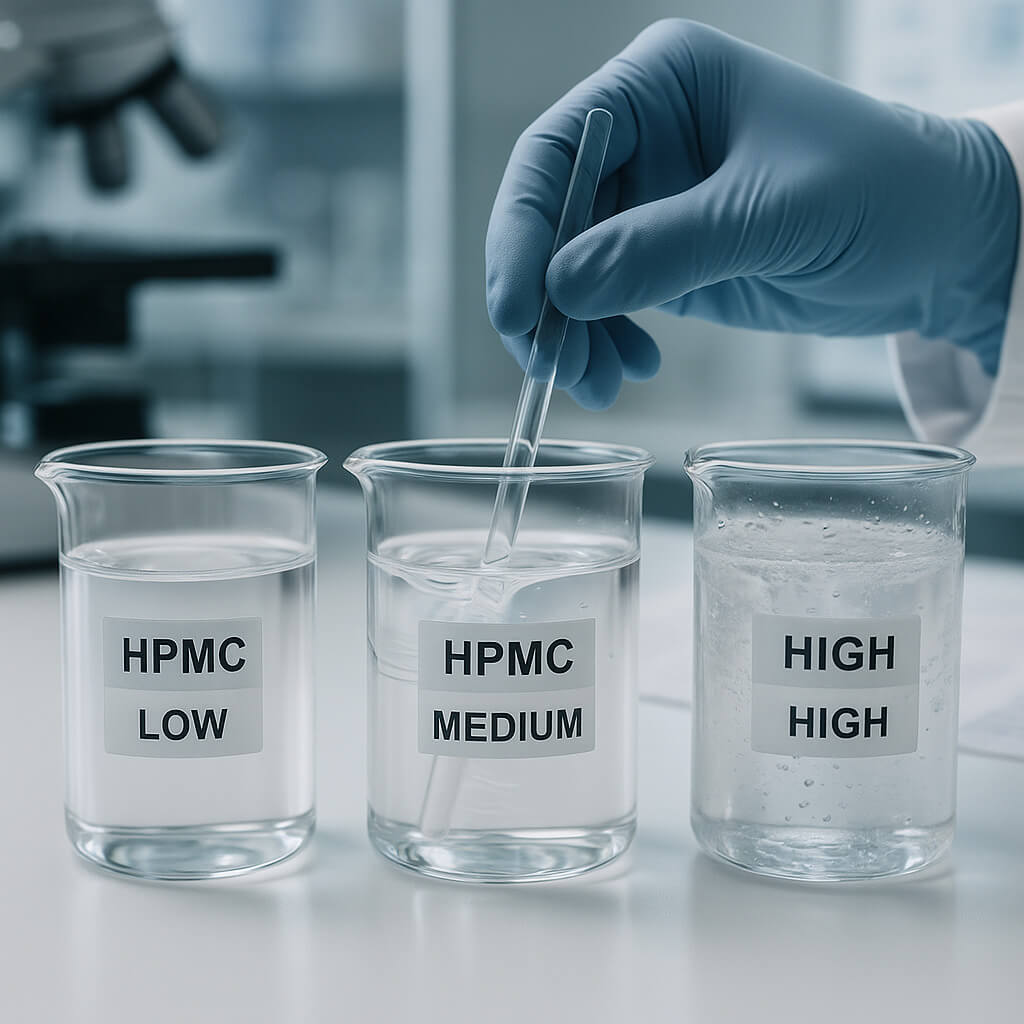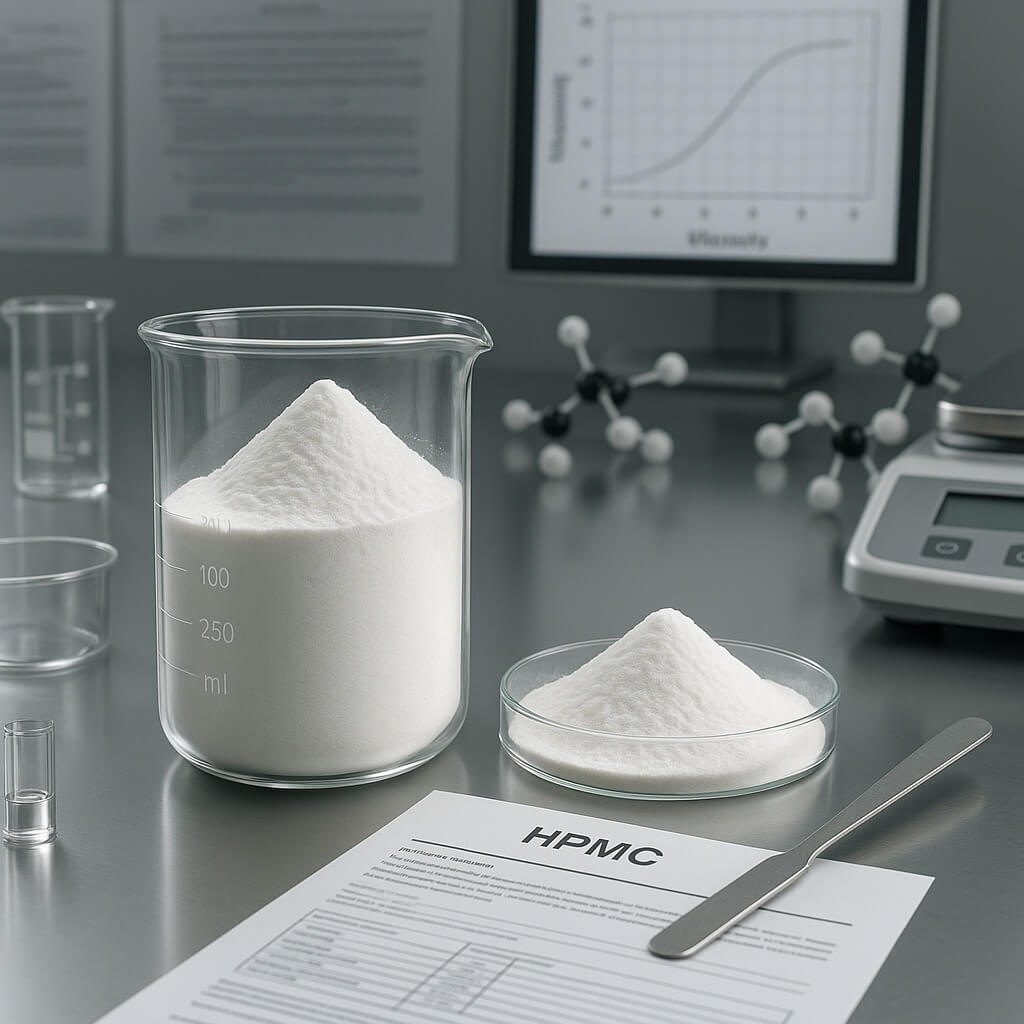Hydroxypropyl Methylcellulose (HPMC) stands as one of the most versatile polymers in modern industry, offering an exceptional range of functional properties that enable its use across diverse applications. This semi-synthetic derivative of cellulose has become indispensable in pharmaceuticals, construction materials, food products, personal care items, and specialized applications. Its unique combination of binding, film-forming, rheological, and surface-active properties makes it a multifunctional ingredient that can address multiple formulation challenges simultaneously. This article explores HPMC’s key functional properties and how these properties are leveraged across various application domains.

1. What Is HPMC And How Is It Manufactured For Commercial Use?
Hydroxypropyl Methylcellulose is a semi-synthetic polymer derived from natural cellulose through chemical modification. This transformation process converts the abundant natural polymer into a versatile material with tailored functional properties.
Here’s what makes it special: The controlled introduction of methoxyl and hydroxypropyl substituents onto the cellulose backbone creates a polymer with unique solubility, rheological, and surface properties that can be precisely engineered for specific performance requirements.
The chemical composition of HPMC consists of a cellulose backbone with varying degrees of methoxyl (–OCH₃) and hydroxypropyl (–OCH₂CH(OH)CH₃) substitution. These substituents replace hydroxyl groups on the anhydroglucose units, creating an amphiphilic molecule with both hydrophilic and hydrophobic regions.
| Structural Component | Description | Functional Significance | Commercial Impact |
|---|---|---|---|
| squelette en cellulose | Linear chain of anhydroglucose units | Provides mechanical strength and film-forming ability | Determines basic physical properties |
| Methoxyl Groups | Hydrophobic substituents | Enhance organic solubility and thermal gelation | Control water solubility and gelation temperature |
| Groupes hydroxypropyles | Hydrophilic substituents | Improve water solubility and surface activity | Affect dissolution rate and solution clarity |
| Poids moléculaire | Chain length (10,000-1,500,000 Da) | Influences viscosity and mechanical properties | Directly impacts performance in end applications |
The manufacturing process involves treating purified cellulose with sodium hydroxide to create alkali cellulose, followed by reaction with methyl chloride and propylene oxide under controlled conditions. Commercial grades of HPMC are classified by substitution types, viscosity, and particle size distribution.
2. Which Binding And Film-Forming Properties Make HPMC Essential In Pharmaceutical Applications?
The pharmaceutical industry represents one of the largest application areas for HPMC, where its binding and film-forming properties play crucial roles in tablet formulation, controlled release systems, and film coating technologies.
What you need to understand is that HPMC’s unique combination of binding strength, controlled hydration, and film formation capabilities makes it exceptionally versatile across multiple pharmaceutical applications, often eliminating the need for multiple excipients.
Tablet binding mechanisms of HPMC involve several processes. During wet granulation, HPMC in solution forms adhesive bridges between particles that solidify upon drying, creating strong mechanical bonds. In direct compression, HPMC particles deform under pressure and form bonds through mechanical interlocking and hydrogen bonding.
| Demande pharmaceutique | HPMC Functional Property | Mécanisme d'action | Clinical Benefit |
|---|---|---|---|
| Tablet Binding | Adhesion and cohesion | Forms solid bridges between particles | Ensures tablet integrity and consistent dosing |
| Controlled Release Matrix | Hydration and gel formation | Creates diffusion barrier around active ingredient | Provides sustained drug release over extended periods |
| Film Coating | Film formation and adhesion | Forms continuous protective layer | Protects against moisture, light, and taste masking |
| Capsule Manufacturing | Thermal gelation | Forms stable gel at elevated temperatures | Creates vegetarian alternative to gelatin capsules |
Controlled release matrix formation represents one of HPMC’s most valuable pharmaceutical applications. When an HPMC-based matrix tablet contacts gastrointestinal fluids, the polymer hydrates and forms a gel layer around the tablet. This gel layer acts as a diffusion barrier, controlling the release rate of the active pharmaceutical ingredient.
Film coating characteristics of HPMC make it ideal for pharmaceutical tablet coating applications. HPMC forms smooth, continuous films with excellent adhesion to tablet surfaces. These films provide effective barriers against moisture, oxygen, and light, enhancing product stability.
3. How Do The Rheological Properties Of HPMC Enhance Construction Products?
The construction industry has embraced HPMC as a critical additive in cement-based systems, where its rheological properties significantly improve workability, water retention, and overall performance.
Here’s the remarkable aspect: HPMC can simultaneously improve seemingly contradictory properties in construction materials—enhancing both flow and sag resistance, extending working time while maintaining setting performance, and improving water retention without compromising strength development.
Water retention mechanisms in cement-based systems represent one of HPMC’s most valuable contributions to construction products. HPMC molecules bind water through hydrogen bonding and physical entrapment within the polymer network, preventing rapid water loss to porous substrates or through evaporation.
| Demande de permis de construire | HPMC Functional Property | Performance Benefit | Application Advantage |
|---|---|---|---|
| Cement-Based Mortars | Rétention d'eau | Prevents premature drying and ensures complete cement hydration | Improves bond strength and reduces cracking |
| Adhésifs pour carrelage | Rheology modification | Provides appropriate consistency for application and prevents slippage | Enables faster installation and better tile alignment |
| Renders and Plasters | Workability improvement | Enhances spreadability and reduces application effort | Increases productivity and improves finish quality |
| Composés autonivelants | Flow control | Balances flow properties for proper leveling without segregation | Creates smooth, flat surfaces with minimal effort |
Workability improvement in mortars and renders is achieved through HPMC’s ability to modify rheological properties. HPMC solutions exhibit pseudoplastic (shear-thinning) behavior, where viscosity decreases under applied shear but recovers when shear is removed. This property makes mortars and renders easy to mix, pump, and apply, but resistant to sagging or slumping after application.
Sag resistance and open time extension are critical for tile adhesives and wall renders. HPMC increases the yield stress of fresh mortars, preventing slippage of heavy tiles and sagging of thick render layers. Simultaneously, it extends the open time by slowing water evaporation.
4. What Functional Properties Make HPMC Valuable In Food And Beverage Applications?
The food industry utilizes HPMC’s multifunctional properties to enhance texture, stability, and processing characteristics across a wide range of products. As a food additive (E464), HPMC offers clean-label advantages and versatile functionality.
What makes this particularly valuable is that HPMC can simultaneously serve multiple functions in food systems—thickening, stabilizing, emulsifying, and forming—often replacing several individual additives and simplifying formulations.
Thickening and stabilization mechanisms in food applications leverage HPMC’s ability to increase solution viscosity and form structured networks. In aqueous systems, HPMC molecules hydrate and unfold, creating entanglements that increase viscosity and provide stability to dispersed particles or droplets.
| Application alimentaire | HPMC Functional Property | Product Benefit | Consumer Advantage |
|---|---|---|---|
| Gluten-Free Baked Goods | Structure formation | Mimics gluten network and improves dough elasticity | Better texture and volume in gluten-free products |
| Fried Foods | Film formation and thermal gelation | Creates moisture barrier during frying | Reduces oil absorption and improves crispness |
| Sauces and Dressings | Thickening and stabilization | Prevents separation and provides consistent texture | Improved mouthfeel and extended shelf life |
| Plant-Based Alternatives | Emulsification and binding | Stabilizes plant proteins and creates cohesive structure | Better texture and mouthfeel in meat alternatives |
Emulsification and texture modification capabilities stem from HPMC’s amphiphilic nature. At oil-water interfaces, HPMC molecules orient with hydrophobic groups toward the oil phase and hydrophilic groups toward the water phase, reducing interfacial tension and forming a protective layer around oil droplets.
Thermal gelation properties of HPMC create unique opportunities in food applications. Unlike most hydrocolloids that lose viscosity when heated, HPMC solutions form thermoreversible gels when heated above a critical temperature. In fried foods, HPMC forms a gel barrier during frying that reduces oil absorption while maintaining moisture.
5. How Is HPMC Utilized In Personal Care And Cosmetic Formulations?
The personal care and cosmetic industry leverages HPMC’s functional properties to enhance product performance, stability, and sensory attributes. From skin care to hair care products, HPMC provides multifunctional benefits.
The key advantage here is that HPMC offers excellent compatibility with a wide range of cosmetic ingredients while providing multiple functional benefits, allowing formulators to create stable, effective products with enhanced sensory profiles.
Film-forming and conditioning properties make HPMC valuable in skin care and hair care applications. On skin, HPMC forms a light, non-occlusive film that provides temporary protection, improves moisture retention, and enhances the delivery of active ingredients. On hair, it forms a thin film that improves combability and reduces static.
| Personal Care Application | HPMC Functional Property | Formulation Benefit | Consumer Experience |
|---|---|---|---|
| Skin Care Creams and Lotions | Film formation and moisture retention | Stabilizes emulsions and enhances active delivery | Smooth application and improved skin feel |
| Hair Styling Products | Film formation and fixative properties | Creates flexible hold without stiffness | Natural-looking style with good humidity resistance |
| Cleansing Products | Rheology modification | Controls flow properties and suspension stability | Rich texture and smooth application |
| Makeup Products | Binding and film formation | Enhances powder cohesion and wear properties | Better application and longer-lasting results |
Rheology modification in cleansing products allows formulators to create systems with ideal flow and suspension properties. HPMC increases the viscosity of shampoos, shower gels, and liquid soaps, providing the desired thickness and flow characteristics for easy dispensing and application.
Stabilization of emulsions and suspensions is achieved through multiple mechanisms. HPMC increases the viscosity of the continuous phase, reducing the mobility of dispersed droplets or particles. It also forms a protective layer around dispersed phases, providing steric hindrance that prevents aggregation.
6. What Specialized Applications Leverage HPMC’s Unique Functional Properties?
Beyond the major application areas, HPMC’s versatile functional properties enable its use in numerous specialized applications where its unique combination of characteristics addresses specific technical challenges.
What’s particularly interesting is that HPMC continues to find new applications as industries discover how its unique property profile can solve emerging technical challenges, demonstrating the remarkable versatility of this polymer.
Ophthalmic solutions and artificial tears represent a specialized pharmaceutical application where HPMC’s biocompatibility and rheological properties are particularly valuable. HPMC increases the viscosity of eye drops, prolonging contact time with the ocular surface and improving drug delivery or lubrication.
| Specialized Application | HPMC Functional Property | Technical Advantage | Market Impact |
|---|---|---|---|
| Solutions ophtalmiques | Viscosity and biocompatibility | Prolongs contact time without blurring vision | Improves treatment efficacy and patient comfort |
| 3D Printing | Rheology control and binding | Enables precise extrusion and layer adhesion | Facilitates complex geometries and functional parts |
| Agricultural Formulations | Film formation and controlled release | Creates protective barriers and modulates active release | Improves efficacy and reduces environmental impact |
| Ceramic Processing | Binder and rheology modifier | Controls flow properties and green strength | Enables complex shapes and improves manufacturing yield |
3D printing applications utilize HPMC as a rheology modifier and binder in various printing formulations. In extrusion-based systems, HPMC provides the ideal flow properties—yielding under pressure during extrusion but quickly recovering structure after deposition to maintain shape fidelity.
Agricultural formulations benefit from HPMC’s film-forming and controlled-release properties. In seed coatings, HPMC forms protective films that improve handling, reduce dust-off of active ingredients, and control germination timing.
7. How Are HPMC’s Functional Properties Optimized For Specific Applications?
Optimizing HPMC’s functional properties for specific applications requires a systematic approach that considers both the polymer characteristics and the application requirements. This optimization process enables formulators to achieve desired performance while minimizing cost.
Here’s the essential insight: Successful application of HPMC depends not just on selecting the right grade, but on understanding how to leverage its properties through proper formulation, processing, and application techniques.
Grade selection criteria provide structured approaches to matching HPMC grades with application requirements. The primary selection parameters include viscosity (determined by molecular weight), substitution type (ratio of methoxyl to hydroxypropyl groups), and particle size distribution.
| Optimization Approach | Description | Application Example | Performance Impact |
|---|---|---|---|
| Grade Selection | Choosing appropriate viscosity, substitution type, and particle size | High-viscosity grades for extended-release tablets | Determines baseline functional properties |
| Concentration Adjustment | Modifying HPMC dosage to achieve target properties | Increasing concentration for stronger gel formation | Fine-tunes performance within grade capabilities |
| Synergistic Combinations | Combining HPMC with complementary polymers | HPMC with xanthan gum for enhanced suspension stability | Achieves properties not possible with HPMC alone |
| Processing Optimization | Adjusting dissolution, mixing, and application methods | Hot/cold technique for efficient dispersion | Maximizes functional performance of selected grade |
Formulation strategies for property enhancement involve combining HPMC with other ingredients to achieve synergistic effects. Common approaches include blending different HPMC grades to achieve intermediate properties and combining HPMC with other polymers for complementary functionality.
Processing considerations address the practical aspects of working with HPMC. Proper dispersion is critical for achieving optimal functionality, often requiring specialized techniques such as the “hot/cold” method, where HPMC is first dispersed in hot water to prevent lumping, then cooled to allow complete hydration.
Conclusion
Hydroxypropyl Methylcellulose (HPMC) stands as a remarkable example of how chemical modification of a natural polymer can create a versatile material with diverse functional properties applicable across multiple industries. From its fundamental chemical structure to its complex rheological behavior, HPMC offers formulators and product developers a multifunctional ingredient that can address numerous technical challenges simultaneously.
The key to HPMC’s versatility lies in its balanced property profile—combining water solubility with organic compatibility, providing viscosity modification with pseudoplastic flow, forming films with controlled dissolution, and offering surface activity without irritation potential. These properties make HPMC valuable across pharmaceuticals, construction materials, food products, personal care items, and numerous specialized applications.
Understanding how to optimize HPMC’s functional properties through grade selection, formulation strategies, and processing techniques enables technical professionals to leverage this versatile polymer effectively. As industries continue to seek multifunctional, sustainable, and cost-effective ingredients, HPMC’s diverse functional properties ensure its continued importance in both established and emerging applications.
FAQ
Q1: How do different grades of HPMC compare in terms of their functional properties?
HPMC grades differ primarily in three key parameters that influence their functional properties: viscosity (determined by molecular weight), substitution type (ratio of methoxyl and hydroxypropyl groups), and particle size. Higher viscosity grades provide stronger thickening, better suspension stability, and more robust gel formation, making them ideal for extended-release pharmaceuticals and high-performance construction products. Lower viscosity grades offer better sprayability, faster dissolution, and clearer solutions, suitable for film coatings and liquid formulations. Substitution type affects solubility characteristics—higher methoxyl content increases organic solubility and lowers thermal gelation temperature, while higher hydroxypropyl content improves cold water solubility.
Q2: Can HPMC be combined with other polymers to enhance specific functional properties?
HPMC can be effectively combined with other polymers to achieve synergistic effects or complementary functionality. Common combinations include: HPMC with other cellulose derivatives like ethylcellulose to create films with modulated dissolution profiles for pharmaceutical controlled release; HPMC with natural gums such as xanthan gum to enhance suspension stability in food and personal care products; HPMC with polyvinyl alcohol to improve film flexibility and adhesion in coating applications; HPMC with carbomers to create stable gel networks with enhanced mucoadhesion for topical pharmaceutical formulations; and HPMC with redispersible polymer powders in construction products to improve flexibility and adhesion.
Q3: What are the key differences between HPMC and other cellulose derivatives in terms of functional properties?
HPMC offers a distinct functional property profile compared to other cellulose derivatives. Versus Methylcellulose (MC), HPMC provides better cold water solubility and lower thermal gelation temperatures, though MC forms stronger thermal gels. Compared to Carboxymethylcellulose (CMC), HPMC is non-ionic and thus maintains stable viscosity across a wider pH range and in the presence of electrolytes, but provides less thickening efficiency. Hydroxyethylcellulose (HEC) provides higher clarity in solution than HPMC but lacks thermal gelation properties. Ethylcellulose (EC) is water-insoluble unlike HPMC, making it suitable for water-resistant barriers but limiting its use in aqueous systems.
Q4: How do environmental conditions affect HPMC’s functional properties in various applications?
Environmental conditions significantly impact HPMC’s functional properties. Temperature has perhaps the most dramatic effect—as temperature increases, HPMC solution viscosity initially decreases but then increases sharply as it approaches its thermal gelation temperature (typically 65-90°C depending on grade). This thermal gelation is reversible upon cooling. Humidity affects both dry HPMC powder (causing caking at high humidity) and HPMC films (increasing plasticity and permeability at high humidity). pH has minimal effect on HPMC properties between pH 3-11 due to its non-ionic nature, but extreme pH conditions can cause hydrolysis during prolonged exposure.
Q5: What regulatory considerations apply to HPMC’s use across different application areas?
Regulatory considerations for HPMC vary by application area and geographic region. In pharmaceuticals, HPMC must comply with pharmacopeial standards (USP/NF, Ph. Eur., JP) that specify identity, purity, and functional parameters. For food applications, HPMC is approved as food additive E464 in Europe and has GRAS (Generally Recognized as Safe) status in the US, with specific purity requirements and usage limits in certain food categories. In personal care and cosmetics, HPMC is listed in the INCI dictionary as “Hydroxypropyl Methylcellulose” and is generally considered safe for cosmetic use, though regulations vary by country.




